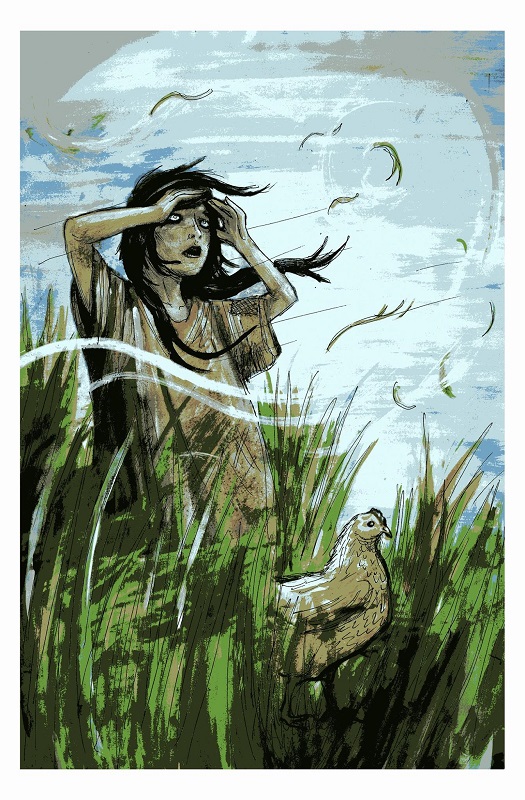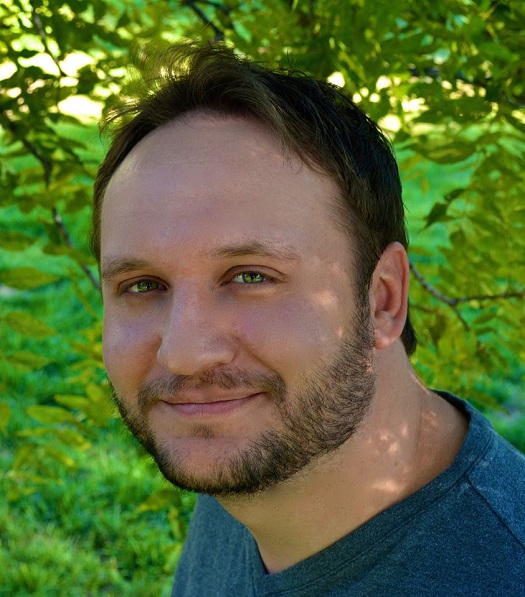By Austin Kaus
If you sat and had a glass of whiskey with Doug Murano, you might not suspect that his love – after his family and dogs, of course – is horror. Raised in Huron and currently residing in the Black Hills, Murano speaks with a smile and looks like a pleasant everyman. However, he’s also a published horror author with a taste for the macabre.
When he’s not working at being the communications and promotions coordinator for the Horror Writer’s Association and the social media director for the World Horror Convention in Atlanta next year, he’s busy making final edits to two upcoming horror anthologies – Shadows Over Main Street and Gruesome Faces, Ghastly Places – that feature world-renowned authors and the darkest corners of the human mind. In anticipation to this year’s release of both books, Murano chatted about his history, work, and why humans like having the crap scared out of them.
Give some history of the project. How did it come together?
DM: The genesis for Shadows Over Main Street happened last fall when a horror author named D. Alexander Ward approached me out of the blue with an idea for an anthology we would co-edit. We’re close friends now, but at the time, I didn’t really know him other than from recognizing his name from a few independent horror anthologies in which I’d also placed stories. I’m still not sure why he came to me with the idea, other than that it must have been fate—but I’m glad he did.
Ward initially had this crazy plan that we’d release a call for submissions that would combine the mythos and aesthetics established by H.P. Lovecraft with the hometown innocence of the fictional Mayberry from The Andy Griffith Show. (Lovecraft’s influenced horror writers and filmmakers from Stephen King and Clive Barker to Ridley Scott and Guillermo Del Toro.) The anthology was designed to answer this question: What happens when ancient, cosmic evil beyond human comprehension (a la Lovecraft) descends upon the sleepy town of Mayberry?
If I’m totally honest – and Ward’s aware of this – I almost told him I wasn’t interested and left it at that. Life was insanely busy for me at that point, we foresaw some intellectual property issues with putting our anthology in the Mayberry universe and I wasn’t that excited about reading dozens of submissions I was sure would feature Barney Fife staring down the shaking barrel of his revolver at unspeakable horrors born of a vast and uncaring cosmos.
As the days went on, Ward’s enthusiasm infected my imagination and I couldn’t shake the idea. The possibilities kept me up at night for reasons I can’t explain. Soon, I began to ask “What if?” which is almost always a promising sign when it comes to the projects that I end up taking on. The incredible tension between unimaginably vast evil and the mythical-yet-familiar innocence of the types of places throughout rural America I’ve known since childhood . . . that was the sweet spot at the heart of Ward’s original idea. So, I figured, why not remove the troublesome Mayberry bits from the equation and do a straight take on small-town Lovecraftian terror?
I saw great potential in this approach, and to Ward’s credit, he agreed to adjust the vision for what was, essentially, his baby.
How involved have you been?
DM: Ward and I will be credited as editors on the book’s cover, but the fact is we’ve involved ourselves every step of the way from the beginning. After we finalized the idea for the anthology, we began soliciting stories from a handful of authors. We (also) found an outstanding publishing partner in Hazardous Press, who understood our vision for the book and agreed to fund us at the level we requested.
Most importantly, our publisher has allowed us to maintain almost total creative control throughout the process. This means Ward and I solicited stories directly from authors, accepted or rejected authors’ submissions, worked with our writers on story edits, influenced the look and feel of the cover art, proposed the final order of the table of contents, developed the back-cover copy … you name it, we had a significant hand in it.
How much work has this been for you?
DM: This project has represented dozens and dozens of hours of work, sleep-deprived nights and many evenings holed up with my computer, away from my family. A sacrifice for sure—and one I’ve hoisted upon my wife and kids as much as anyone. Without their love and support, it wouldn’t have been possible to make this happen.
That said, it’s been a labor of love from start to finish, and I’ve had an excellent editing partner in D. Alexander Ward. We began with an idea and nothing more—no publisher, no funding, very few prospects for authors. Today we can say without exaggeration that we’ve worked with some of the best in the business. I’m quite simply astounded at the level of talent we’ve attracted, especially since this is our first outing in terms of editing an anthology.
You’re going to find some barn burners in Shadows Over Main Street. Top to bottom, I’d put our table of contents up against any other horror anthology released this year, maybe longer—the stories are that consistently good. You may not yet have heard of all of the authors we’re featuring, but there’s a good chance that, if you’re a horror fan, you’ll want to know more about all of them once you’ve finished Shadows Over Main Street.
So, yes, it’s been a ton of work, but to have collaborated with the talent we’ve brought on board has been a humbling, educational, gratifying experience.
What kind of stories are you working on now?
DM: The short answer to this question is that I’m working on very few stories of my own—life is pretty full right now. The long answer is as follows:
Shadows Over Main Street has taken up much of my free time. My wife and I have two children under the age of three, and another on the way, so things are pleasantly chaotic on the home front.
You have another anthology coming down the pipe too, right?
DM: Even though time and energy are scarce these days, I’ve teamed up with two other South Dakota-based horror writers, Adrian Ludens and C.W. LaSart, to assemble a collection of short horror stories called Gruesome Faces, Ghastly Places, which will be out sometime before the end of the year. The collection consists mostly of reprints from the past several years (with stories from all three of us), but features a few never-before-seen stories, along with fantastic illustrations from an artist who’s popped up everywhere this year, Luke Spooner. It’s been a treat to work with everyone involved, and I’m thrilled to have had the chance to contribute my brand of horror to the book.
As for brand-new material, it’s skewing quite a bit darker than my past work, though I’m not sure why. In August, I completed a story called “Pajamas” that my beta readers and editors have called everything from “brutal and original” to “quirky and bizarre.” The story just missed the cut for an anthology featuring horror greats Jack Ketchum and Edward Lee, so I’m hopeful that I’ll soon find a market for that one, even though it’s a little off-the-wall. I have another one in the works called “Unburied,” which started off as a horror homage to “Antigone” by Sophocles, that I think is my attempt at working through my feelings about the Boston Marathon bombings and other horrific acts of violence that seem to appear on the news every day.
This is probably going to sound strange, but I’m also working on a children’s book. Go ahead and chuckle. I’m hoping to spend the fall and winter with that project.
“LaSart, Ludens, and Murano prove power trios aren’t only for rock and roll. Like great rock music, the stories in Gruesome Faces, Ghastly Places will send a chill down your spine and leave you wanting more.” -James Chambers, The Engines of Sacrifice and Three Chords of Chaos
What’s the scariest thing you’ve ever written?
DM: That’s a tough one. Maybe it’s best to explain that every story puts me through a different wringer. For example, I wrote a story called “The Chopping Block,” which is set in a post-apocalyptic world—and I told it through the voice of a psychologically scarred little girl, so I had to try to get into that terrorized mindset in order to pull it off. “Pajamas,” my most recent effort, took a lot out of me because in some ways I was writing about the parts of myself I don’t like. The storyline itself is not autobiographical by any means but, for thematic reasons, I had to think about the logical extremes of some of the less appealing parts of my personality. That’s not exactly a fun thing to do, and is scary … but in a more subtle way than, say, something like “Hostel.” But for straight-up horror, I’d have to point to “Chums,” a story I wrote a while back that’s all about that feeling you get when you swim in a deep lake and you feel like anything could be down there … anything at all.

Why horror? What draws you to it?
DM: The truth is, I don’t know. My mind is always piecing together a narrative of some sort, and when I make a record of that process, more often than not, it comes out as a story you could classify as “horror.” I don’t revel in violence, death and destruction but somehow they always show up in my work.
When is the first time you remember being scared in your life?
DM: Good question, but perhaps a little too personal and I don’t want to have to throw B.S. your way and tell you that it was spiders in my grandpa’s horse barn or something equally lame. Gotta keep a little mystery for myself.
What’s the scariest thing you’ve ever read?
DM: I read Stephen King’s It when I was probably too young for it, and it’s my personal standard for perfection when it comes to horror storytelling. Lord of the Flies stuck with me, too, from a very young age. Also, there was that time I tried to read one of Bill O’Reilly’s books back in college, for the sake of open-mindedness. Shook me up pretty bad.
Pennywise or having two-soon-to-be-three children – which is scarier?
DM: It’s probably a tossup. Both cause plenty of sleepless nights and both can rip your heart right out of your body and force you to watch it beat.
Why do you think people read horror?
DM: On a superficial level, it’s the same reason people ride roller coasters or rubberneck at car wrecks. Something within us likes to consider our own deaths from a relatively safe vantage point. It’s a cathartic experience to go through the depths of hell, witness the end of the world or face down some sort of monster and come out O.K. on the other side.
Digging a little deeper—and I think some of the enduring monsters in literature and film bear this idea out—we use horror as a way to examine our own depravity and capacity for evil. Reading horror is a socially acceptable way for us to acknowledge that we identify with the monster. Amidst the chills and screams, we all have moments when we hope the monster will win the day.
Murano blogs at muranofiction.blogspot.com and can be found in the darkest corner of Twitter @muranofiction. For more information on Shadows Over Main Street, go to mainstreetshadows.com. Both Main Street Shadows and Gruesome Faces, Ghastly Places are expected to be available by on Amazon by Halloween.




















